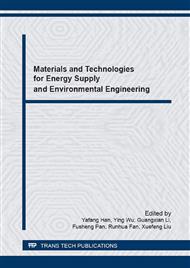p.425
p.431
p.437
p.445
p.451
p.456
p.460
p.466
p.472
Research on Produced Fluid Corrosion Resistance Oil Well Cement Paste System in Adjustment Well
Abstract:
To design oil well cement paste system and ensure well cementation quality of adjustment well in work area of tertiary oil recovery (EOR), the composition, microstructure and strength of cement paste matrix eroded by producing water were tested and studied by HTHP Curing Chamber, HTHP corrosion tester, X-ray diffraction, scanning electron microscope (SEM), universal testing compressor and some other laboratory equipment according to the condition that producing water contains sulfate (SO42-) and bicarbonate (HCO3-). The corrosion law and mechanism of oil well cement paste matrix were analyzed. The problem for designing corrosion resistance oil well cement paste system was investigated. The corrosion law and mechanism of oil well cement paste matrix by SO42- and HCO3- were raised. The corrosion resistant oil well cement paste system was designed, which was suitable to the adjustment well in area of EOR in Daqing. The results show that the compositions of cement paste matrix changed after corrosion by SO42- and HCO3- for a long term. The secondary gypsum, ettringite and calcite were produced, which changed the microstructures and declined the compressive strength of cement paste matrix. The change degree of compressive strength of cement paste matrix was affected by corrosion media concentration, corrosion time and other conditions. The higher concentration of corrosion media and the longer of corrosion time were, the greater decline of cement strength occurred. The formula of corrosion resistance oil well cement paste system was designed, for which the high sulfate resistant cement as architectural substrate and the PZW as admixtures were used to improve the strength and penetration resistance ability of cement.
Info:
Periodical:
Pages:
451-455
Citation:
Online since:
March 2016
Authors:
Price:
Сopyright:
© 2016 Trans Tech Publications Ltd. All Rights Reserved
Share:
Citation:


